Spatial and Temporal Distribution Characteristics and Source Apportionment of VOCs in Lianyungang City in 2018
Abstract
:1. Introduction
2. Materials and Methods
2.1. Sampling Time and Sites
2.2. Sample Collection and Analysis
2.3. Other Data
2.4. Principal Component Analysis
3. Results and Discussion
3.1. Meteorological Characteristics and Volatile Organic Compounds (VOCs) Characteristics in Different Seasons
3.2. Seasonal Variation of VOCs Components
3.3. Seasonal Variation of Typical VOCs Species
3.4. Specific Species Ratios
3.5. Ozone Formation Potential (OFP) Analysis
3.6. Principal Component Analysis (PCA)
4. Conclusions
- (1)
- Ozone pollution in Lianyungang was the most serious in May and June, and the high value of ozone concentration appeared at the same time with the high value of VOCs concentration. Comparing the concentration variation of VOCs at different sampling sites, they were industrial area (36.06 ± 12.2 µg m−3) > urban area (33.47 ± 13.0 µg m−3) > suburban area (27.68 ± 9.8 µg m−3).
- (2)
- The seasonal variation of VOCs was approximately the same in the urban and suburban areas, which was different from that in the industrial area. While the concentrations of different components were at similar levels in the urban and industrial areas, which were significantly higher than that in the suburban area.
- (3)
- The possible sources and relative importance of VOCs in Lianyungang City were measured by the ratio of toluene/benzene (T/B), ethane/acetylene (E/E) and isopentane /TVOCs. The results showed that traffic sources of VOCs may dominate in Lianyungang City (/B ~ 2), and there were obvious aging phenomena at the five sampling sites (E/E > 4). The ratio of isopentane/TVOCs implied that the contribution of gasoline volatilization sources in urban and suburban areas may contribute more than those in industrial area.
- (4)
- Aromatics (40.32–58.09%) contributed the most to OFP at the five sampling sites. The top 10 OFP species showed that controlling n-hexane and aromatics, such as benzene, toluene, xylene, and trimethylbenzene, in Lianyungang City can effectively control ozone generation.
- (5)
- The sources of VOCs in different areas in Lianyungang were relatively consistent. Five sources were analyzed at the two sampling sites in urban areas: industrial emission + plants, vehicle exhaust, fuel evaporation, combustion and industrial raw materials. Four sources were analyzed in industrial areas: industrial emission + plants, vehicle exhaust, fuel evaporation and combustion. Five sources were analyzed at the two sampling sites in the suburban area: industrial emission + plants, vehicle exhaust, fuel evaporation, combustion and solvent usage.
Supplementary Materials
Author Contributions
Funding
Institutional Review Board Statement
Informed Consent Statement
Acknowledgments
Conflicts of Interest
References
- Guo, S.; Hu, M.; Zamora, M.L.; Peng, J.; Zhang, R. Elucidating severe urban haze formation in China. Proc. Natl. Acad. Sci. USA 2014, 111, 17373–17378. [Google Scholar] [CrossRef] [PubMed] [Green Version]
- Likun, X.; Tao, W.; Louie, P.K.K.; Luk, C.W.Y.; Blake, D.R.; Zheng, X. Increasing external effects negate local efforts to control ozone air pollution: A case study of Hong Kong and implications for other Chinese cities. Environ. Sci. Technol. 2014, 48, 10769–10775. [Google Scholar]
- Zhang, Q.; Yuan, B.; Shao, M.; Wang, X.; Liu, S. Variations of ground-level O3 and its precursors in Beijing in summertime between 2005 and 2011. Atmos. Chem. Phys. 2014, 14, 6089–6101. [Google Scholar] [CrossRef] [Green Version]
- Ke, L.; Jacob, D.J.; Liao, H.; Shen, L.; Bates, K.H. Anthropogenic drivers of 2013–2017 trends in summer surface ozone in China. Proc. Natl. Acad. Sci. USA 2019, 116, 422–427. [Google Scholar]
- An, J.L.; Zhu, B.; Wang, H.L.; Yang, H. Variation characteristics and source analysis of atmospheric VOCs in the northern suburbs of Nanjing. Environ. Sci. 2014, 12, 4454–4464. [Google Scholar]
- Chen, C.H.; Su, L.Y.; Wang, H.L.; Huang, C.; Li, L.; Zhou, M.; Qiao, Y.Z.; Chen, Y.R.; Chen, M.H.; Huang, H.Y.; et al. Annual variation characteristics and key active components of VOCs in Shanghai urban area. J. Environ. Sci. 2012, 32, 367–376. [Google Scholar]
- Gao, Z.J.; Gao, S.; Cui, H.X.; Fu, Q.Y.; Jin, D.; Liang, G.P.; Fang, F. Study on VOCs Characteristics and Activity of Typical Photochemical Process in Summer in a Chemical Industry District in Shanghai. J. Environ. Sci. 2017, 37, 1251–1259. [Google Scholar]
- Wang, H.L. The relationship between chemical depletion of volatile organic compounds and ozone production in Shanghai. Environ. Sci. 2015, 9, 3159–3167. [Google Scholar]
- Yang, X.X.; Tang, L.L.; Zhang, Y.J.; Mu, Y.F.; Wang, M.; Chen, W.T.; Zhou, H.C.; Hua, Y.; Jiang, R.X. Correlation analysis of characteristics of VOCs and O3 generation potential in Nanjing summer urban area. Environ. Sci. 2016, 2, 443–451. [Google Scholar]
- Li, L.; Xie, S.; Zeng, L.; Wu, R.; Jing, L. Characteristics of volatile organic compounds and their role in ground-level ozone formation in the Beijing-Tianjin-Hebei region, China. Atmos. Environ. 2015, 113, 247–254. [Google Scholar] [CrossRef]
- Luo, D.T.; Gao, J.; Wang, S.L.; Zhang, Y.C.; Zhang, M.; Chai, F.H. Analysis of characteristics of atmospheric volatile organic compounds and related pollutants in autumn in Beijing. J. Univ. Chin. Acad. Sci. 2014, 31, 329–336. [Google Scholar]
- Zhang, Y.; Wang, X.; Zhou, Z.; Lv, S.; Li, L. Sources of C2-C4 alkenes, the most important ozone nonmethane hydrocarbon precursors in the Pearl River Delta region. Sci. Total Environ. 2015, 502, 236–245. [Google Scholar] [CrossRef]
- Zou, Y.; Deng, X.J.; Zhu, D.; Gong, D.C.; Wang, H. Characteristics of 1 year of observational data of VOCs, NOx and O3 at a suburban site in Guangzhou, China. Atmos. Chem. Phys. 2015, 15, 6625–6636. [Google Scholar] [CrossRef] [Green Version]
- Zheng, H.; Kong, S.F.; Xing, X.L.; Mao, Y.; Hu, T.P.; Ding, Y.; Li, G.; Liu, D.T.; Li, S.L.; Qi, S.H. Monitoring of volatile organic compounds (VOCs) from an oil and gas station in northwest China for 1 year. Atmos. Chem. Phys. 2018, 18, 4567–4595. [Google Scholar] [CrossRef] [Green Version]
- Li, L.; An, J.Y.; Shi, Y.Y.; Zhou, M.; Wu, J. Source apportionment of surface ozone in the Yangtze River Delta, China in the summer of 2013. Atmos. Environ. 2016, 144, 194–207. [Google Scholar] [CrossRef]
- Shao, P.; An, J.L.; Xin, J.Y.; Wu, F.K.; Wang, J.X.; Ji, D.S.; Wang, Y.S. Source apportionment of VOCs and the contribution to photochemical ozone formation during summer in the typical industrial area in the Yangtze River Delta, China. Atmos. Res. 2016, 176, 64–74. [Google Scholar] [CrossRef]
- Xu, Z.; Huang, X.; Nie, W.; Chi, X.; Xu, Z.; Zheng, L.; Sun, P.; Ding, A. Influence of synoptic condition and holiday effects on VOCs and ozone production in the Yangtze River Delta region, China. Atmos. Environ. 2017, 168, 112–124. [Google Scholar] [CrossRef]
- Ministry of Ecology and Environment of the People’s Republic of China. Ambient Air-Determination of Volatile Organic Compounds-Collected by Specially-Prepared Canisters and Analyzed by Gas Chromatography/Mass Spectrometry (HJ 759-2015); Ministry of Ecology and Environment of the People’s Republic of China: Beijing, China, 2015. [Google Scholar]
- Thurston, G.D.; Spengler, J.D. A Quantitative Assessment of Source Contributions to Inhalable Particulate Matter Pollution in Metropolitan Boston. Atmos. Environ. 1987, 19, 9–25. [Google Scholar] [CrossRef]
- Miller, S.L.; Anderson, M.J.; Daly, E.P.; Milford, J.B. Source apportionment of exposures to volatile organic compounds. I. Evaluation of receptor models using simulated exposure data. Atmos. Environ. 2002, 36, 3629–3641. [Google Scholar] [CrossRef]
- Zhang, L.; Zhang, X.Z.; Qin, W.; Mao, J.J.; Qin, Y.H.; Xie, W.P.; Shi, W.K.; Chen, W.T. Analysis on the characteristics and source of atmospheric VOCs in Yixing City during the G20 Summit. Environ. Sci. 2017, 38, 2718–2727. [Google Scholar]
- Zhang, B.T.; An, X.X.; Wang, Q.; Yan, H.; Liu, B.X.; Zhang, D.W. Spatial-temporal distribution and reactivity characteristics of atmospheric VOCs in Beijing in 2015. Environ. Sci. 2018, 39, 4400–4407. [Google Scholar]
- Yu, X.F.; Cheng, P.; Gu, Y.G.; Li, M.; Tian, Z.L. Research on the potential of VOCs to generate ozone and SOA in summer in Guangzhou. China Environ. Sci. 2018, 38, 830–837. [Google Scholar]
- Li, C.L. Analysis on Pollution Characteristics of VOCs in the Atmosphere in Xuzhou City in Spring. Environ. Res. Monit. 2017, 4, 46–51. [Google Scholar]
- He, Q.S.; Yan, Y.L.; Li, H.Y.; Zhang, Y.Q.; Chen, L.G. Characteristics and reactivity of volatile organic compounds from non-coal emission sources in China. Atmos. Environ. 2015, 115, 153–162. [Google Scholar] [CrossRef]
- Tang, J.H.; Chu, K.W.; Chan, L.Y.; Chen, Y.J. Non-methane hydrocarbon emission profiles from printing and electronic industrial processes and its implications on the ambient atmosphere in the Pearl River Delta, South China. Atmos. Pollut. Res. 2014, 5, 151–160. [Google Scholar] [CrossRef] [Green Version]
- Liu, Y.; Shao, M.; Fu, L.; Lu, S.; Zeng, L.; Tang, D. Source profiles of volatile organic compounds (VOCs) measured in China: Part I. Atmos. Environ. 2008, 42, 6247–6260. [Google Scholar] [CrossRef]
- Wang, Q.; Geng, C.S.; Chen, W.; Shao, M. Emission factors of gaseous carbonaceous species from residential combustion of coal and crop residue briquettes. Front. Environ. Sci. Eng. 2013, 7, 66–76. [Google Scholar] [CrossRef]
- Tsai, W.Y.; Chan, L.Y.; Blake, D.R.; Chu, K.W. Vehicular fuel composition and atmospheric emission in South China: Hong Kong, Mecau, Guangzhou and Zhuhai. Atmos. Chem. Phys. 2006, 6, 3281–3288. [Google Scholar] [CrossRef] [Green Version]
- Carter, W.P.L. Development of ozone reactivity scales for volatile organic compounds. J. Air Waste Manag. Assoc. 1994, 44, 881–899. [Google Scholar] [CrossRef] [Green Version]
- McCarthy, M.C.; Aklilu, Y.A.; Brown, S.G.; Lyder, D.A. Source apportionment of volatile organic compounds measured in Edmonton, Alberta. Atmos. Environ. 2013, 81, 504–516. [Google Scholar] [CrossRef]
- Barletta, B.; Meinardi, S.; Rowland, F.S.; Chan, C.Y.; Wang, X.; Zou, S.; Chan, L.Y.; Blake, D.R. Volatile organic compounds in 43 Chinese cities. Atmos. Environ. 2005, 39, 5979–5990. [Google Scholar] [CrossRef] [Green Version]
- Wang, H.L.; Yang, Z.X.; Jing, S.A. Volatile organic compounds (VOCs) source profiles of on-road vehicle emissions in China. Sci. Total Environ. 2017, 607, 253–261. [Google Scholar]
- Qiao, Y.Z.; Wang, H.L.; Huang, C.; Chen, C.H.; Su, L.Y.; Zhou, M.; Xu, Y.; Zhang, G.F.; Chen, Y.R.; Li, L.; et al. VOCs source composition spectrum and atmospheric reaction activity of vehicle exhaust emissions. Environ. Sci. 2012, 33, 1071–1079. [Google Scholar]
- Mo, Z.W.; Lu, S.H.; Li, Y.; Shao, M.; Qu, H. Characteristics of VOCs Emissions from Typical Solvent-Using Enterprises in Beijing. China Environ. Sci. 2015, 35, 374–380. [Google Scholar]
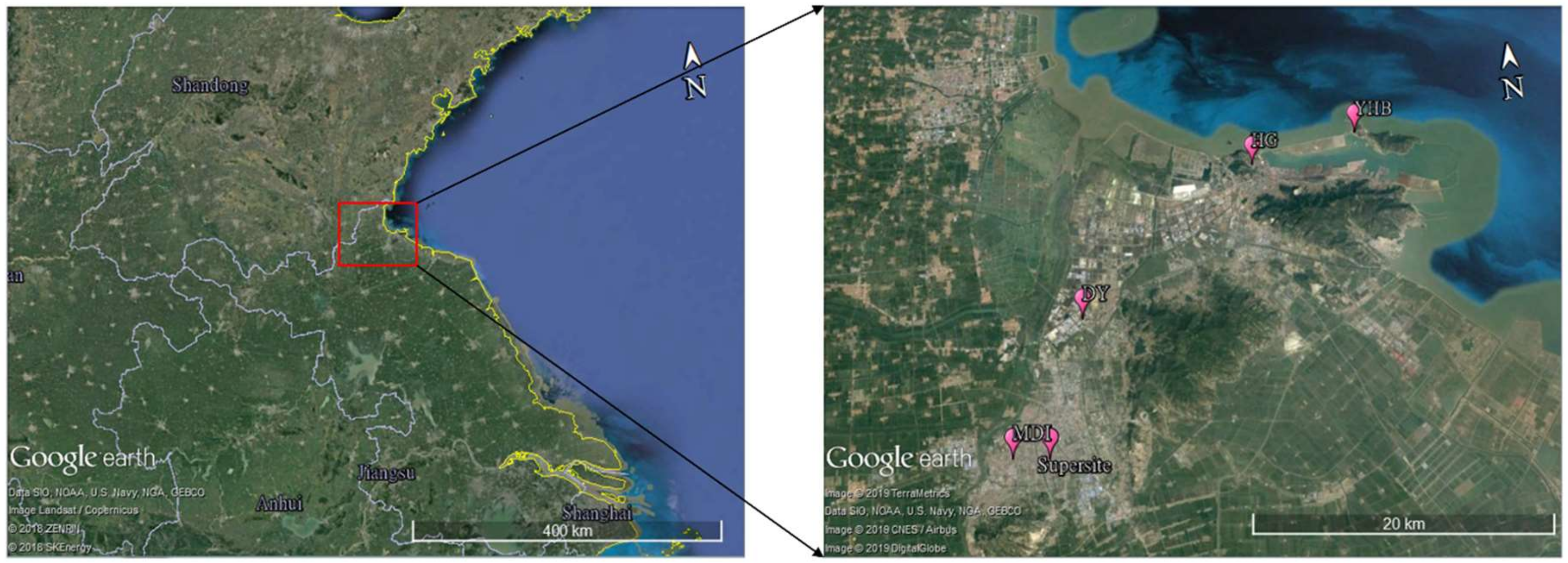

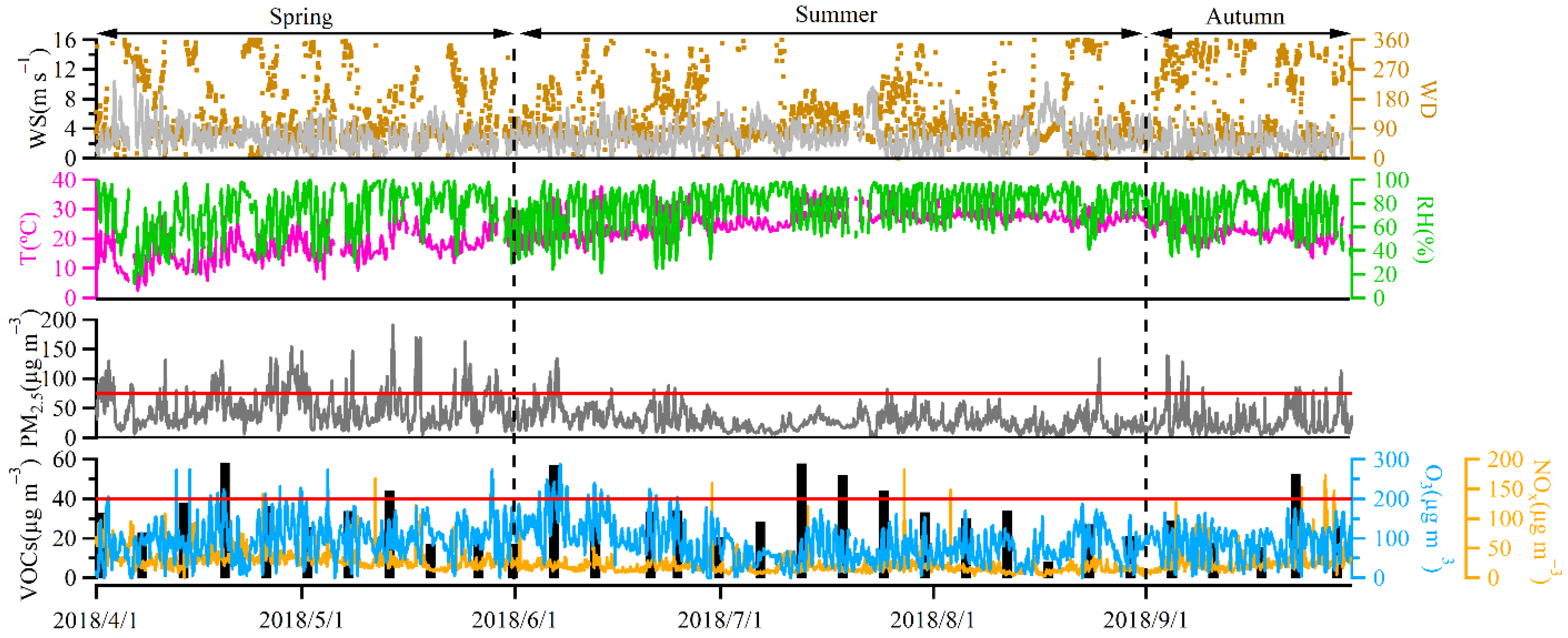
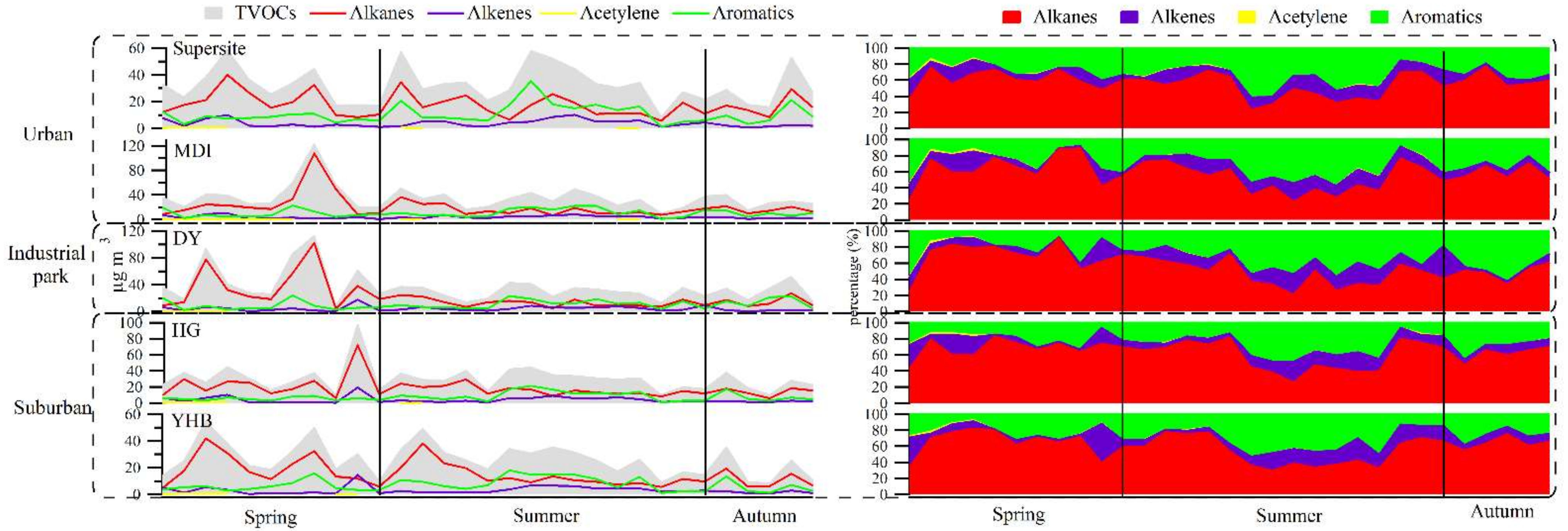
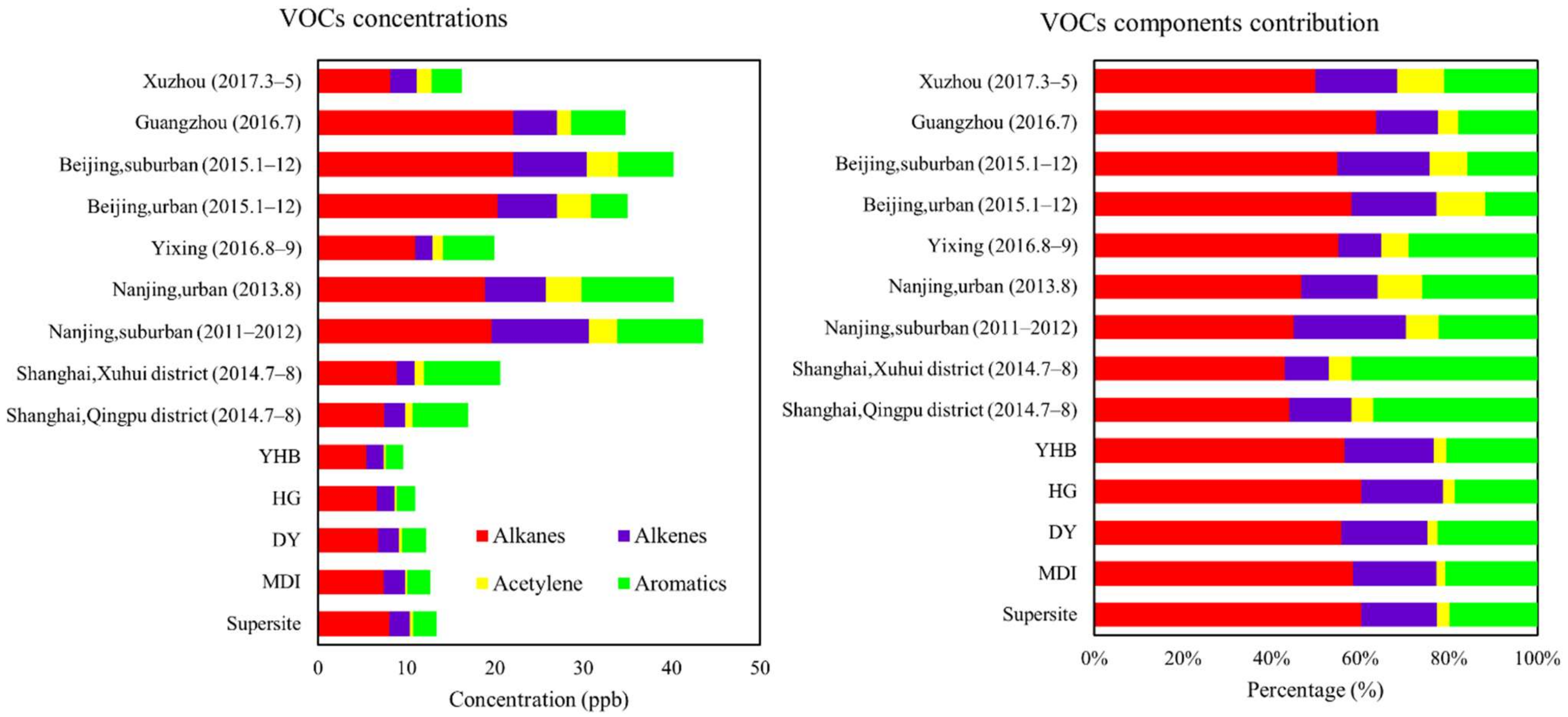


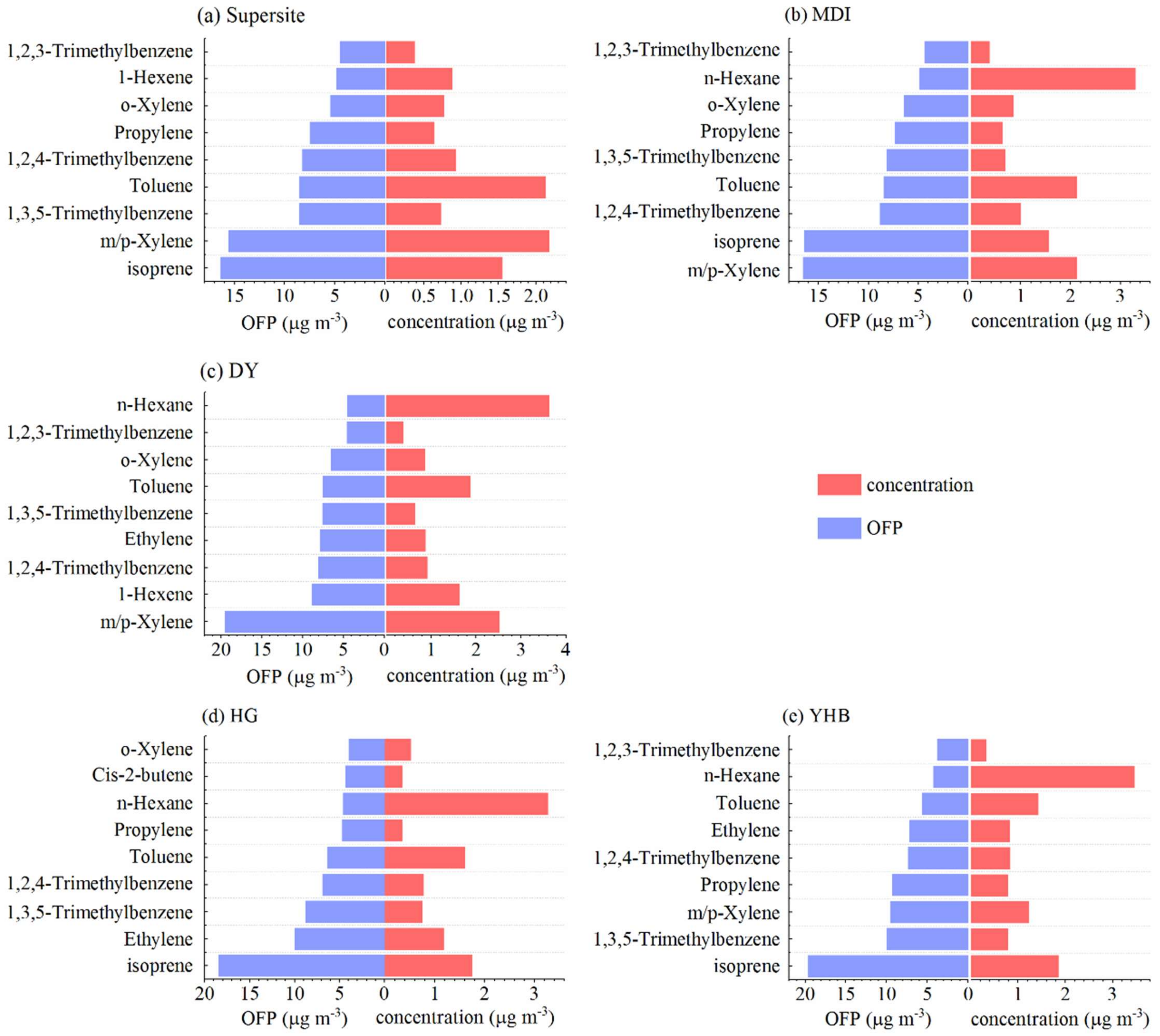
| Sampling Sites | Abbreviation | Longitude and Latitude | Functional Zones |
|---|---|---|---|
| Lianyungang City Environmental Monitoring Supersite | Supersite | 119.18° E, 34.59° N | Urban |
| Mine Design Institute | MDI | 119.14° E, 34.59° N | Urban |
| Deyuan Pharmaceutical Factory | DY | 119.34° E, 34.70° N | Industrial park |
| Hugou Management Office | HG | 119.37° E, 34.74° N | Suburban |
| Yuehai Building | YHB | 119.45° E, 34.77° N | Suburban |
| VOCs (µg m−3) | Supersite | MDI | DY | HG | YHB |
|---|---|---|---|---|---|
| Alkanes | 19.42 ± 10.1b | 28.80 ± 8.7a | 35.72 ± 16.9 | 22.99 ± 7.6a | 19.07 ± 5.9a |
| Alkenes | 3.69 ± 3.2a | 3.83 ± 3.4a | 4.38 ± 2.5 | 4.52 ± 3.3a | 3.19 ± 1.9a |
| Acetylene | 0.61 ± 0.2a | 0.43 ± 0.3a | 0.50 ± 0.2 | 0.59 ± 0.3a | 0.38 ± 0.2a |
| Aromatics | 7.92 ± 2.8a | 9.18 ± 6.6a | 8.37 ± 7.2 | 5.32 ± 2.0a | 5.82 ± 3.7a |
| VOCs | 31.65 ± 12.9a | 42.24 ± 13.4a | 48.96 ± 21.9 | 33.43 ± 10.0a | 28.45 ± 8.7a |
| VOCs (µg m−3) | Supersite | MDI | DY | HG | YHB |
|---|---|---|---|---|---|
| Alkanes | 16.47 ± 6.1a | 15.59 ± 6.5a | 13.02 ± 5.8 | 15.81 ± 4.6a | 13.89 ± 6.4a |
| Alkenes | 4.55 ± 2.5a | 4.45 ± 2.0a | 4.79 ± 2.5 | 3.99 ± 2.5a | 3.55 ± 1.9a |
| Acetylene | 0.32 ± 0.2a | 0.14 ± 0.0a | 0.10 ± 0.1 | 0.19 ± 0.1a | 0.21 ± 0.1a |
| Aromatics | 12.99 ± 8.6a | 11.75 ± 7.1a | 10.91 ± 6.0 | 9.40 ± 6.2a | 9.04 ± 5.4a |
| VOCs | 34.32 ± 12.5a | 31.94 ± 11.1a | 28.82 ± 9.4 | 29.39 ± 9.7a | 26.68 ± 8.8a |
| VOCs (µg m−3) | Supersite | MDI | DY | HG | YHB |
|---|---|---|---|---|---|
| Alkanes | 16.79 ± 7.7a | 15.80 ± 5.0a | 14.63 ± 8.0 | 14.00 ± 5.1a | 10.66 ± 6.3a |
| Alkenes | 1.73 ± 0.7a | 2.28 ± 1.1a | 1.37 ± 0.5 | 1.98 ± 0.7a | 1.62 ± 1.0a |
| Acetylene | - | 0.10 ± 0.0 | 0.07 ± 0.0 | 0.07 ± 0.0 | - |
| Aromatics | 9.76 ± 6.8a | 9.16 ± 4.1a | 14.35 ± 8.1 | 7.29 ± 5.8a | 5.34 ± 5.1b |
| VOCs | 28.28 ± 14.8a | 27.34 ± 8.9a | 30.42 ± 15.1 | 23.34 ± 10.4a | 17.62 ± 12.2b |
| Functional Areas | Seasons | Ethane/ µg m−3 | Propane/ µg m−3 | Isopentane/ µg m−3 | Ethylene/ µg m−3 | Propylene/ µg m−3 | Acetylene/ µg m−3 | Benzene/ µg m−3 | Toluene/ µg m−3 | Ethylbenzene/ µg m−3 | M/P-Xylene/ µg m−3 |
|---|---|---|---|---|---|---|---|---|---|---|---|
| MyUrban | Spring | 2.13 ± 2.2 | 4.41 ± 2.1 | 1.21 ± 0.9 | 2.46 ± 3.3 | 0.77 ± 0.7 | 0.50 ± 0.3 | 1.24 ± 0.5 | 2.05 ± 1.3 | 0.58 ± 0.4 | 1.79 ± 2.1 |
| Summer | 0.48 ± 0.8 | 2.76 ± 1.4 | 1.15 ± 0.8 | 0.52 ± 0.5 | 0.66 ± 0.8 | 0.23 ± 0.2 | 1.00 ± 0.6 | 2.00 ± 1.1 | 0.77 ± 0.5 | 2.52 ± 1.7 | |
| Autumn | 0.53 ± 0.6 | 3.17 ± 1.8 | 1.69 ± 0.7 | 0.34 ± 0.1 | 0.28 ± 0.1 | 0.10 ± 0.0 | 1.35 ± 0.9 | 2.64 ± 1.7 | 0.53 ± 0.3 | 1.29 ± 0.8 | |
| Industrial park | Spring | 1.43 ± 2.0 | 3.19 ± 1.6 | 1.58 ± 1.8 | 1.86 ± 2.4 | 0.27 ± 0.2 | 0.50 ± 0.2 | 0.95 ± 0.4 | 2.04 ± 2.2 | 0.63 ± 0.7 | 2.11 ± 2.7 |
| Summer | 0.18 ± 0.1 | 1.89 ± 1.1 | 0.76 ± 0.6 | 0.34 ± 0.1 | 0.47 ± 0.4 | 0.10 ± 0.1 | 0.91 ± 0.6 | 1.76 ± 0.9 | 0.65 ± 0.3 | 2.70 ± 2.1 | |
| Autumn | 0.79 ± 1.1 | 2.96 ± 2.0 | 0.94 ± 0.4 | 0.29 ± 0.1 | 0.23 ± 0.1 | 0.07 ± 0.0 | 1.31 ± 1.1 | 1.83 ± 0.8 | 1.29 ± 1.1 | 2.78 ± 1.4 | |
| Suburban | Spring | 1.78 ± 2.3 | 2.69 ± 1.6 | 0.83 ± 0.8 | 1.84 ± 2.5 | 0.27 ± 0.3 | 0.46 ± 0.3 | 0.88 ± 0.4 | 1.36 ± 1.3 | 0.42 ± 0.4 | 0.89 ± 0.6 |
| Summer | 0.38 ± 0.5 | 1.93 ± 1.2 | 0.77 ± 0.5 | 0.39 ± 0.2 | 0.42 ± 0.3 | 0.19 ± 0.1 | 0.79 ± 0.5 | 1.55 ± 1.0 | 0.53 ± 0.2 | 1.73 ± 1.1 | |
| Autumn | 0.55 ± 0.7 | 2.31 ± 1.5 | 1.09 ± 0.7 | 0.37 ± 0.1 | 0.22 ± 0.1 | 0.07 ± 0.0 | 1.45 ± 1.1 | 1.72 ± 1.8 | 0.44 ± 0.4 | 0.81 ± 0.9 |
| OFP (µg m−3) | Supersite | MDI | DY | HG | YHB |
|---|---|---|---|---|---|
| Alkanes | 28.09 ± 15.2 | 29.17 ± 15.6 | 26.87 ± 14.0 | 24.99 ± 12.4 | 22.30 ± 12.6 |
| Alkenes | 39.16 ± 21.1 | 42.70 ± 22.4 | 26.67 ± 13.8 | 45.46 ± 22.8 | 51.67 ± 26.4 |
| Aromatics | 70.84 ± 34.6 | 72.29 ± 37.9 | 74.20 ± 28.6 | 47.60 ± 23.6 | 56.35 ± 29.3 |
| VOCs | 138.09 ± 70.2 | 144.66 ± 74.6 | 127.74 ± 65.2 | 118.05 ± 60.4 | 130.32 ± 66.8 |
Publisher’s Note: MDPI stays neutral with regard to jurisdictional claims in published maps and institutional affiliations. |
© 2021 by the authors. Licensee MDPI, Basel, Switzerland. This article is an open access article distributed under the terms and conditions of the Creative Commons Attribution (CC BY) license (https://creativecommons.org/licenses/by/4.0/).
Share and Cite
Chen, C.; Wang, L.; Zhang, Y.; Zheng, S.; Tang, L. Spatial and Temporal Distribution Characteristics and Source Apportionment of VOCs in Lianyungang City in 2018. Atmosphere 2021, 12, 1598. https://doi.org/10.3390/atmos12121598
Chen C, Wang L, Zhang Y, Zheng S, Tang L. Spatial and Temporal Distribution Characteristics and Source Apportionment of VOCs in Lianyungang City in 2018. Atmosphere. 2021; 12(12):1598. https://doi.org/10.3390/atmos12121598
Chicago/Turabian StyleChen, Cheng, Lingrui Wang, Yunjiang Zhang, Shanshan Zheng, and Lili Tang. 2021. "Spatial and Temporal Distribution Characteristics and Source Apportionment of VOCs in Lianyungang City in 2018" Atmosphere 12, no. 12: 1598. https://doi.org/10.3390/atmos12121598





